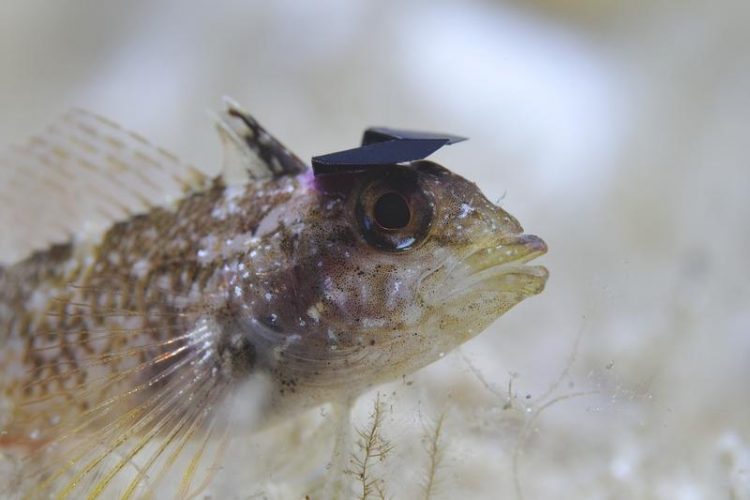Small fish reflect on their enemies

Throwing shade: Tiny hats prevented the Yellow Black-faced Triplefin from reflecting sunlight with its eyes. As a result, hatted triplefins moved closer to scorpionfish than hatless triplefins Photo: Nico Michiels
Small fish use light for active sensing to detect potential predators. The Yellow Black-faced Triplefin (Tripterygion delaisi) can reflect downwelling sunlight sideways with its iris, illuminating its immediate surroundings.
A team headed by Professor Nico Michiels from the Institute of Evolution and Ecology at the University of Tübingen has now shown that the fish actively reflects light to locate predators such as the Black Scorpionfish (Scorpaena porcus).
When the deflected sunlight hits the eyes of a scorpionfish, it is reflected back ‒ and warns the triplefin to keep a safe distance. The results of Michiels' team have been published in the latest Proceedings of the Royal Society B.
Some animal species actively send out signals and detect their reflections to locate prey or nearby objects. For example, bats emit ultrasound to find their way by echolocation. Using the emission of light to trigger visible reflections was previously only known from nocturnal flashlight fish. These use bioluminescence to improve their vision in the dark.
But until now, there has been no research into the use of sunlight by diurnal fish such as triplefins. Just four centimeters long, the Yellow Black-faced Triplefin lives at a depth of about ten meters in the Atlantic and Mediterranean.
It can tilt and rotate its eyes to deflect the incident sunlight from its iris. Previously, the Tübingen biologists already proposed that this can help it to find tiny shrimps, their favorite prey.
The current study now demonstrates that this mechanism also allows triplefins to improve visual detection of their predator. Scorpionfish are common, well-camouflaged sit-and-wait predators on marine substrates. When the light deflected by a triplefin reaches a scorpionfish’s retro-reflecting eyes, they light up like cat's eyes, warning the triplefin of the danger.
In laboratory and field experiments in Corsica, the Tübingen biologists attached tiny hats to the fish to prevent them from redirecting sunlight. Treated like this, triplefins approached a scorpionfish (presented behind glass) closer than their hatless counterparts in the control group did.
If a neutral object like a stone was presented, all fish approached it closely, regardless of how they had been treated.
“The deflected light is weak,” says Professor Nico Michiels, “but visual modelling shows that it can generate a reflection in the scorpionfish’s eyes that is strong enough to be perceived by the triplefin.”
Michiels and his team estimate that they can detect this change in pupil brightness over distances of seven centimeters or more. This is enough to escape from a lurking scorpionfish. “We suspect that this form of active perception is widespread in small fish,” Michiels says.
Professor Dr. Nico Michiels
University of Tübingen
Faculty of Science
Animal Physiological Ecology
Phone +49 7071 29-74649
nico.michiels[at]uni-tuebingen.de
Matteo Santon, Pierre-Paul Bitton, Jasha Dehm, Roland Fritsch, Ulrike K. Harant, Nils Anthes und Nico K. Michiels. Redirection of ambient light improves predator detection in a diurnal fish. Proceedings of the Royal Society B, https://doi.org/10.1098/rspb.2019.2292
Media Contact
More Information:
https://uni-tuebingen.deAll latest news from the category: Life Sciences and Chemistry
Articles and reports from the Life Sciences and chemistry area deal with applied and basic research into modern biology, chemistry and human medicine.
Valuable information can be found on a range of life sciences fields including bacteriology, biochemistry, bionics, bioinformatics, biophysics, biotechnology, genetics, geobotany, human biology, marine biology, microbiology, molecular biology, cellular biology, zoology, bioinorganic chemistry, microchemistry and environmental chemistry.
Newest articles

Innovative vortex beam technology
…unleashes ultra-secure, high-capacity data transmission. Scientists have developed a breakthrough optical technology that could dramatically enhance the capacity and security of data transmission (Fig. 1). By utilizing a new type…

Tiny dancers: Scientists synchronise bacterial motion
Researchers at TU Delft have discovered that E. coli bacteria can synchronise their movements, creating order in seemingly random biological systems. By trapping individual bacteria in micro-engineered circular cavities and…

Primary investigation on ram-rotor detonation engine
Detonation is a supersonic combustion wave, characterized by a shock wave driven by the energy release from closely coupled chemical reactions. It is a typical form of pressure gain combustion,…



